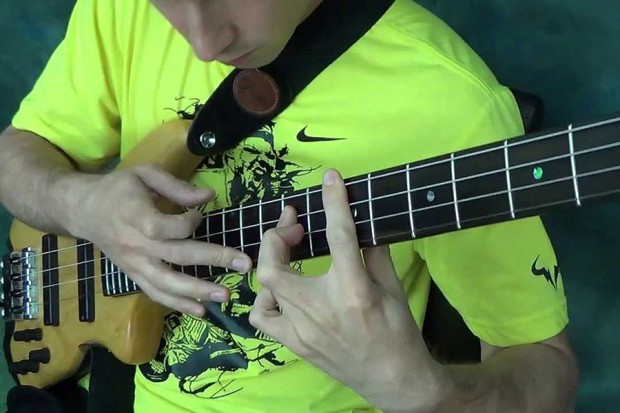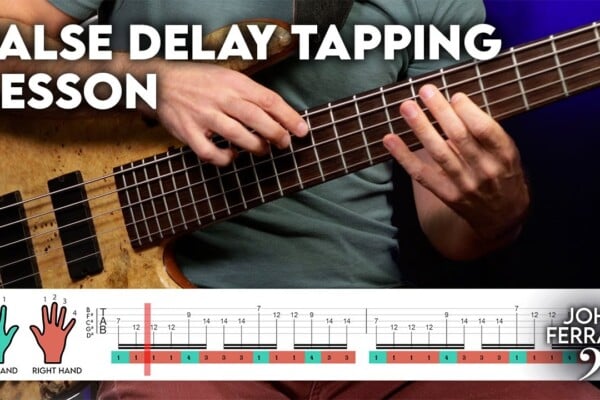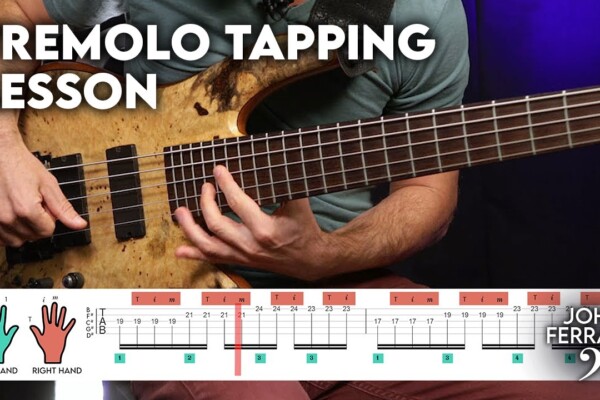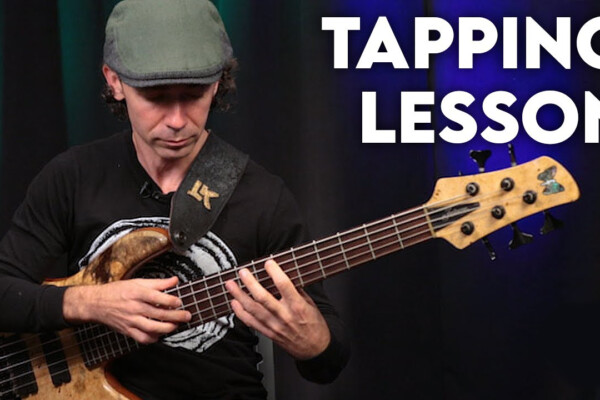Two-Handed Tapping and Developing Hand Independence for Bass Players

Q: I have been practicing two-handed taping and can’t get independence between left and right hand. Specifically, I can’t play rhythm patterns with my fretting hand and independently play harmony with the plucking hand. Can you suggest some workout for this kind of problem?
A: While I have very limited experience with two-handed tapping, I do have experience with working through independence problems (both as a drummer and a bassist.
When getting multiple limbs (or digits) to do more than one thing at once, it becomes all about muscle memory. The more you have to actively think about what you are doing, the less likely you will be do be able to do it. At the very least, you are forced to keep things very simple in order to play with any authority when you don’t have that muscle memory.
When muscle memory is present, one feels as if they are allowing their subconscious mind to take over one of their tasks so that you can better focus on the other task. We’re usually not able to think too deeply about more than one thing at a time.
The same goes for playing through changes: if you have to think about where the notes are on the fretboard, how to articulate the line and what notes are in the chord scale you want to play, it’s unlikely you’ll play anything meaningful and you certainly can’t afford much brain space to dedicate to your ears and interact with other musicians at the asme time.
Playing anything fluidly and with ease presumes that much of the nuts and bolts of what you are doing is built in to your hands and brain, leaving you enough mental function to listen and focus on playing musically.
So what do to? I would suggest you focus your energy on the rhythmic independence of your two hands, initially. Gradually refine that focus to include finger independence as you go and start to feel comfortable.
In other words, start macro and work your way towards micro.
You might even start without the instrument in your hands – or at least, you can use this method to practice when away from your instrument. In the car, sitting in a chair, anywhere…
It could start as simply as learning to play simple drum rudiments with your hands on your knees. Single stroke rolls, double stroke rolls, paradiddles, and so on. (Do a search for beginning drum rudiments and begin there). You can progress beyond this by studying polyrhythms a little bit and learn how to tap 3 against 4 and any number of other polyrhythms. This kind of work will also do wonders for your rhythmic vocabulary and phrasing!
Of course, you can do this on the instrument as well, but I would start simply. Maybe just tapping one note with each hand or even just thumping the strings. Focus on the rhythm and don’t clutter up your attempts with harmony just yet. Get it right before you try and move on.
Remember the quickest results come when we work slowly and with intention. Learn to do it correctly slowly and you will get there much more quickly than you would by starting off too fast to do it properly. Practice precision and control and the speed will come naturally and surprisingly quickly.
The next step would be to incorporate the fingers. Work from the pool of knowledge that you already have under your fingers. Try incorporating a simple scale pattern with your left hand and a rhythm with the left. For example, tap a paradiddle between your left hand rhythmically and your right hand tapping the notes of the scale. You could certainly incorporate harmony into both hands by playing the same scale in unison in each hand. You could also harmonize by starting with the left hand on the root and the left hand on the 3rd, for example. The possibilities are endless.
The key is to take what you know and slowly incorporate new material, while working from that solid foundation. Work those polyrhythms into familiar harmonic patterns. If you are new to tapping, you will likely want to spend some quality time simply getting your right hand to work properly as a fretting hand. Pay attention to your hand position and finger strength and independence. You may simply want to start by just trying to play solid scales and arpeggios with your right hand on the fretboard (using all four fingers, getting good tone and playing with accuracy).
I would imagine that if you develop your right hand independently of your left on the fretboard, get comfortable playing different rhythms with each hand that work together (try thumping clave with one hand and a simple tumbao bass line with the other… yikes!), and slowly pull those things together into one action, you will develop a solid technique a comfort level over time.
Take it slow and think about it methodically. Break it down into it’s simplest steps and make sure that you have each of them working properly by themselves before you try to combine everything into one action.
Let me encourage all of you readers out there to chime in on this question, as I am admittedly out of my depth. Help me out! Please share your thoughts and suggestions in the comments.
Have a question for Damian Erskine? Send it to [email protected]. Check out Damian’s instructional books, Right Hand Drive and The Improviser’s Path.




Thanks for the answer, meant so much
http://www.talkingbass.net/tapping-bass-guitar-lesson-part-1/
Helped me. Part 3 is the one where it really pays off.
The simplest advice that I would have is to break down a simple groove that incorporates a bass line with the LH and a chordal pattern with the RH into little fragments that you practice with a metronome. Eventually you’ll start to piece each fragment together. Even the most complicated and syncopated combination of rhythms become simple when they are divided into small fragments.